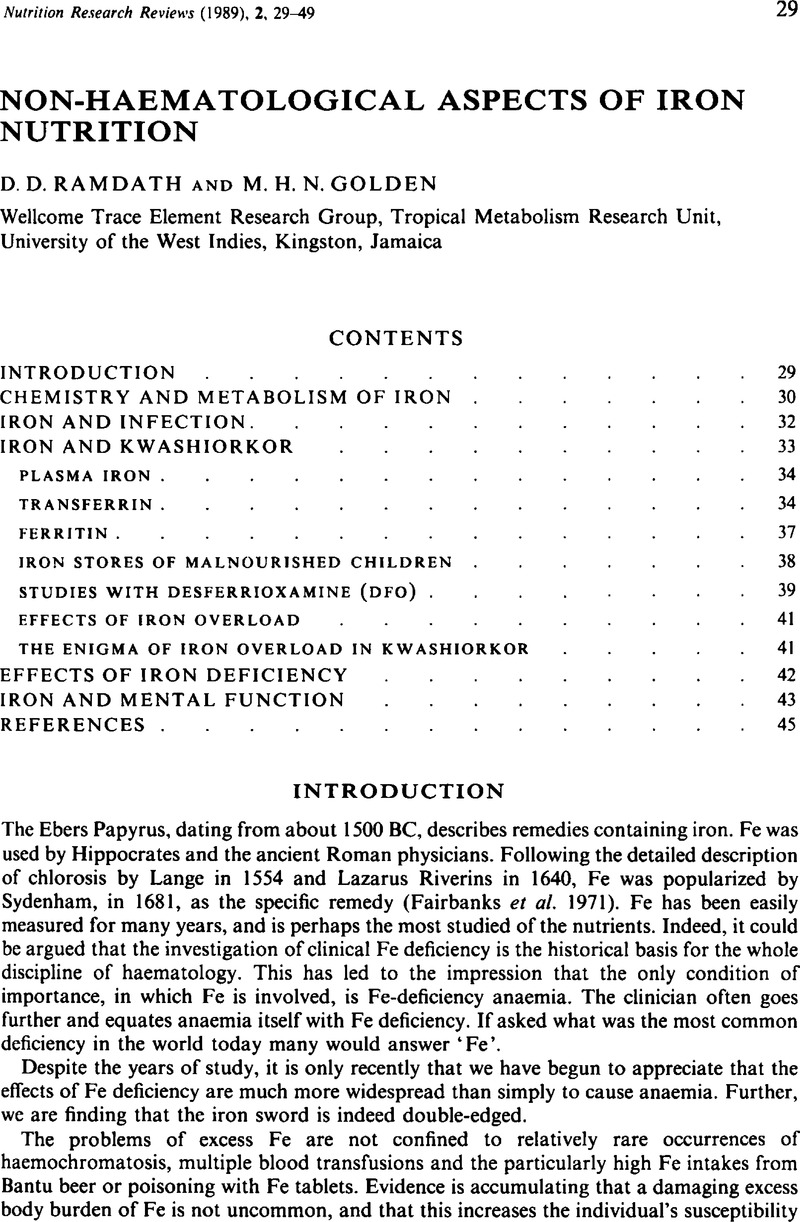Crossref Citations
This article has been cited by the following publications. This list is generated based on data provided by Crossref.
Walker, Ann F.
1990.
The Contribution of Weaning Foods to Protein–Energy Malnutrition.
Nutrition Research Reviews,
Vol. 3,
Issue. 1,
p.
25.
Carpenter, Charles E.
and
Mahoney, Arthur W.
1992.
Contributions of heme and nonheme iron to human nutrition.
Critical Reviews in Food Science and Nutrition,
Vol. 31,
Issue. 4,
p.
333.
Arieli, A.
Schrama, J.W.
Van Der Hel, W.
and
Verstegen, M.W.A.
1995.
Development of Metabolic Partitioning of Energy in Young Calves.
Journal of Dairy Science,
Vol. 78,
Issue. 5,
p.
1154.
Grimble, R.F.
1995.
Interactions between Nutrients and the Immune System.
Nutrition and Health,
Vol. 10,
Issue. 3,
p.
191.
Waterlow, J.C.
1997.
Protein-energy malnutrition: the nature and extent of theproblem.
Clinical Nutrition,
Vol. 16,
Issue. ,
p.
3.
Golden, M.H.N.
1997.
Protein-energy interactions in the management of severemalnutrition.
Clinical Nutrition,
Vol. 16,
Issue. ,
p.
19.
Morlese, John F.
Forrester, Terrence
Del Rosario, Melanie
Frazer, Margaret
and
Jahoor, Farook
1997.
Transferrin Kinetics Are Altered in Children with Severe Protein-Energy Malnutrition , ,.
The Journal of Nutrition,
Vol. 127,
Issue. 8,
p.
1469.
Oken, Emily
and
Lightdale, Jenifer R.
2000.
Updates in pediatric nutrition.
Current Opinion in Pediatrics,
Vol. 12,
Issue. 3,
p.
282.
Scherbaum, Veronika
and
Fürst, Peter
2000.
New concepts on nutritional management of severe malnutrition: the role of protein.
Current Opinion in Clinical Nutrition and Metabolic Care,
Vol. 3,
Issue. 1,
p.
31.
Singhal, Atul
Morley, Ruth
Abbott, Rebecca
Fairweather-Tait, Susan
Stephenson, Terence
and
Lucas, Alan
2000.
Clinical Safety of Iron-Fortified Formulas.
Pediatrics,
Vol. 105,
Issue. 3,
p.
e38.
Golden, Michael H.N.
2002.
The Development of Concepts of Malnutrition.
The Journal of Nutrition,
Vol. 132,
Issue. 7,
p.
2117S.
Jackson, Alan A.
and
Calder, Philip C.
2004.
Handbook of Nutrition and Immunity.
p.
71.
Borelli, Primavera
Blatt, Solange
Pereira, Juliana
Beutler de Maurino, Beatriz
Tsujita, Maristela
Cristina de Souza, Ana
Guilherme Xavier, José
and
Ambrósio Fock, Ricardo
2007.
Reduction of erythroid progenitors in protein–energy malnutrition.
British Journal of Nutrition,
Vol. 97,
Issue. 2,
p.
307.
Golden, Michael H.
2009.
Proposed Recommended Nutrient Densities for Moderately Malnourished Children.
Food and Nutrition Bulletin,
Vol. 30,
Issue. 3_suppl3,
p.
S267.
Fardet, Anthony
2010.
New hypotheses for the health-protective mechanisms of whole-grain cereals: what is beyond fibre?.
Nutrition Research Reviews,
Vol. 23,
Issue. 1,
p.
65.
Kane, Nimsate
Ahmedna, Mohamed
and
Yu, Jianmei
2010.
Development of a fortified peanut‐based infant formula for recovery of severely malnourished children.
International Journal of Food Science & Technology,
Vol. 45,
Issue. 10,
p.
1965.
Golden, Michael H.
2010.
Evolution of nutritional management of acute malnutrition.
Indian Pediatrics,
Vol. 47,
Issue. 8,
p.
667.
Henry Golden, Michael
2015.
Nutritional and other types of oedema, albumin, complex carbohydrates and the interstitium – a response to Malcolm Coulthard's hypothesis: Oedema in kwashiorkor is caused by hypo-albuminaemia.
Paediatrics and International Child Health,
Vol. 35,
Issue. 2,
p.
90.
Bianchi, Vittorio Emanuele
2016.
Role of nutrition on anemia in elderly.
Clinical Nutrition ESPEN,
Vol. 11,
Issue. ,
p.
e1.
Akomo, Peter
Bahwere, Paluku
Murakami, Hitoshi
Banda, Chrissy
Maganga, Elizabeth
Kathumba, Sylvester
Sadler, Kate
and
Collins, Steve
2019.
Soya, maize and sorghum ready-to-use therapeutic foods are more effective in correcting anaemia and iron deficiency than the standard ready-to-use therapeutic food: randomized controlled trial.
BMC Public Health,
Vol. 19,
Issue. 1,



